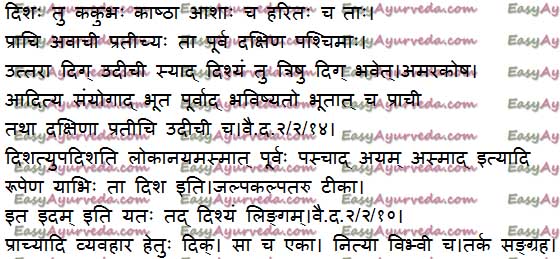Dik – Direction, Ayurvedic Perspective, Importance, Practical Application

By Dr Raghuram Y.S. MD (Ay) & Dr Manasa, B.A.M.S
Travelling and commuting is a part of all our lives. To travel we need direction. Deciding the direction of our lives, very early, is one of the success Mantras.
In ancient times, the physicians used to travel to collect herbs. In the construction of pharmacies, there are clear directions for places regarding storage of herbs, fire area etc. In India the buildings are constructed according to an ancient pattern of engineering which is called Vastu Shastra i.e. science of building in which particular rooms are built facing particular directions. This is said to be conducive to health and prosperity.
Read – Travelling Tips – How To Keep Ayurveda Vata Dosha Balance While Travelling?
Thus, the knowledge of direction helps one in accomplishing many tasks, activities, goals and ambitions in life, including wealth, health and prosperity.

Table of Contents
Direction is a substance
Dik – the direction
Dik or disha means direction. Direction is one among the nine dravyas i.e. substances explained in Ayurveda. To qualify for a substance, it needs to have its own qualities and actions embedded within it related in an inseparable relationship. The direction has its qualities and actions and hence qualifies to be a substance.
Read – Dravya: Meaning, Ayurvedic Explanation
Distance is one, not many
Distance is virtual, shapeless and formless, just like the ether element and time. Thus, the ‘direction’ is one, eternal and all pervading. But virtually, by peculiarity and deceit it appears to be many.
Synonyms of Direction
- Dik, Disha, Kakubha
- Kashta, Aashaa, Harita
Read – Vaisheshika Darshana and Ayurveda: Relation and Similarities
Names of different directions
The direction is only one but for our convenience of travelling we have named them into many. Directions are 10 in number.
- Prachi / purva – East
- Avachi – South
- Pratichi – West
- Udichi – North
- Ishana kona – North-East
- Vayavya kona – North-West
- Nairutya kona – South-West
- Agneya kona – South-East
- Urdhwa desha – Upward direction, sky, space
- Adho desha – Downward direction, sub-earth terrain
Read – Dakshinayana or Visarga Kala (Southern Solstice) Definition, Seasons, Health Effect
Direction and Sun
Directions are determined on the basis of Sun. The point of sunrise is considered to be Purva i.e. east direction. The opposite direction,will be west direction. Towards our right will be south and towards our left will be north. This is how the directions have been determined even from ancient times.
Read – Uttarayana – Adana Kala (Northern Solstice) Definition, Seasons, Effect On Health
Characteristic features of disha
That which helps in determining and explaining things like ‘this is east of that’ or ‘that is west of this’ is called direction. (East and west are only examples).
Direction is that which determines and explains ‘that is from this side’ etc. That which is responsible for all these conversations is called direction.
The substance which puts us into conversations like ‘this is east’, ‘that is south’, ‘this is west’ and ‘that is north’ is called direction.
The knowledge of direction can also be obtained by paratva and aparatva i.e. distance between one place to the other as seen and determined from a particular place. The knowledge which helps us to know that y is far away from x is called paratva. The knowledge which helps us to know that z is nearby to x is called aparatva. Thus, that which can be known through farness and nearness is called distance.
Read – Paratva Aparatva Gunas – Meaning, Benefits

Importance of direction in Ayurveda
a. To know the nature and impact of air and water flowing from different directions on health (A.Sam.Su.12/15-18)
The wind blowing from the east direction is hot and causes oozing and effusions, contaminates the skin, worsens piles, poisoning conditions, worm infestations, conditions caused by simultaneous vitiation of all three doshas, fever and breathing disorders.
Read – Ayurvedic Treatment For Worm Infestation
The breeze coming from the west direction is cold in nature and destroys fainting, burning sensation, thirst and diseases caused due to poisoning.
The air flowing from south direction is auspicious and wholesome, conducive for eye health, provides strength to the body parts, alleviates bleeding disorders caused due to simultaneous contamination of pitta and blood, and doesn’t aggravate vata.
Read – Vata Dosha – Introduction, 40 Things To Know
The breeze flowing from north direction is unctuous, soft, has sweet taste and astringent sub-taste or after-taste, cold in nature and doesn’t aggravate vata.
Similarly, the rivers which fall into the western seas owing to their high speed and being clean and clear are conducive to health. The rivers which flow towards east are unwholesome and non-conducive to health.
Read – Benefits And Usage of Water As per Ayurveda: Complete Compilation
b. To know the nature and impact of water of rivers flowing from different directions on health (A.Sam.Su.6/13-30)
The water of the rivers flowing from Himalaya mountains is conducive to health. The water of the rivers flowing from east, Avanti (Ujjain) and Aparanta (Konkan) regions cause piles on consumption. The water of the rivers flowing from Mahendra Mountains, on consumption produces abdominal disorders, ascites and filariasis. The water of rivers flowing from Sahyadri and Vindyachal mountains produce skin disorders (leprosy), anemia and headache. The water of the rivers flowing from Pariyatra Mountains destroys tridosha aggravation, increases strength and virility.
Read – Elephantiasis: Ayurvedic Treatment, Medicines, Remedies
c. To know the effect of medicinal herbs grown in different geographies and directions (Cha.Ka.1/10)
The medicinal herbs grown in north direction are said to be good and conducive to health, has better disease alleviating properties.
d. To construct buildings for special treatments in relation to directions
For a sudation treatment called Jentaka Sweda a special building need to be constructed. It has been indicated to select a place for construction of the building towards east or north of one’s residence. (Cha.Su.13/46)
Read – Jentaka Sweda and Kuti Sweda – Differences And Similarities
Similarly for a special form of rejuvenation treatment i.e. Kuti Praveshika Vidhi, it has been indicated that the construction of cottage should be done facing east or north direction. (Cha.Chi.1/1/18)
e. To collect the herbs growing in particular directions for efficacy in treatment (cha.chi.1/1/18)
Read – Collection And Preservation Of Ayurvedic Herbs
The herbs are instructed to be collected either by facing east or north direction. The God of east direction is Sun and the God of north direction is Moon. Sun and Moon transfer energies into the herbs and strengthen them. Therefore the herbs should be collected facing those directions.
Click to Consult Dr Raghuram Y.S. MD (Ayu) – Email / Skype









